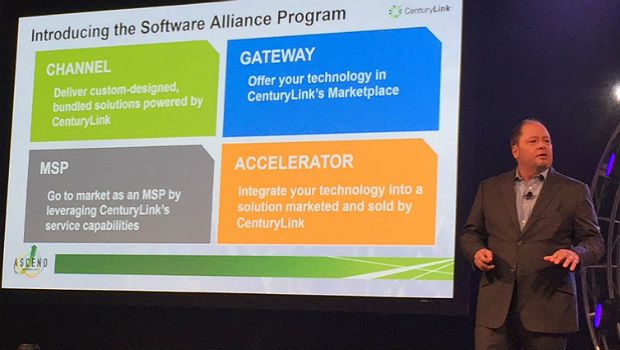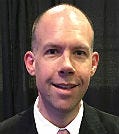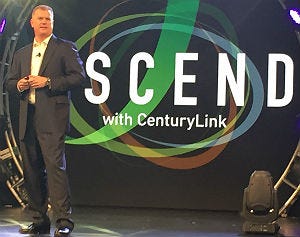The various CenturyLink alliances before long hope to "cross-pollinate" in ways that will benefit partners and end users.

 CenturyLink last week formally introduced a four-pronged approach that gives partners various ways to work with the company.
CenturyLink last week formally introduced a four-pronged approach that gives partners various ways to work with the company.
While you’re probably familiar with the traditional CenturyLink Channel Alliance (CCA) Program, the communications giant spent a full day at its Ascend partner event in San Diego focused not only on CCA, but also its Software Alliance – which just launched a formal channel program – its Systems Integrator Alliance (SIA) and its Strategic Partner Alliance (SPA).
The company hopes to differentiate itself with these four different routes to market.
 We sat down with Gahn Lane (pictured above), named head of the CenturyLink Software Alliance just last year, and Dave Dyas (pictured, right), a seven-year CenturyLink veteran who’s now vice president in charge of the Systems Integrator Alliance, to talk about their goals for their respective programs and what partners should expect from them.
We sat down with Gahn Lane (pictured above), named head of the CenturyLink Software Alliance just last year, and Dave Dyas (pictured, right), a seven-year CenturyLink veteran who’s now vice president in charge of the Systems Integrator Alliance, to talk about their goals for their respective programs and what partners should expect from them.
We interviewed Lane and Dyas separately, but combined them for the purposes of this Q&A. The transcript has been edited for clarity and brevity.
Channel Partners: Gahn, discuss the evolution of the Software Alliance Program since you first discussed it with Channel Partners late last summer.
Gahn Lane: What we’ve done is identified [what we wanted] our route to market to look like. We had a quote unquote channel, but not a channel program. We announced that today (Feb. 23). I had people working on it for about six months. We did a series of interviews with 100 clients and asked them what they would like and what they would need. No. 1, we’re changing the name from “ISV” to “software vertical.” That’s because many of them don’t consider themselves a software vendor; it doesn’t fit them.
CP: Is ISV a dirty word?
GL: ISV is an old, old Cisco term that just became standardized over the years. But very few people understand what that means. If you develop software and you distribute that, you’re not necessarily a vendor. They may deliver lots of different types of software and they don’t see themselves as a vendor. And to your point, vendor is a more caustic term, if you will, and they don’t want to be known as a vendor.
CP: Tell me about the newly announced Software Alliance Program.
GL: Our go-to-market program is very unique in that it’s built around what’s the best fit for [partners] to go to market. You may want to sell our pipes and our managed services white-label; you may want to sell your stuff through us, and that’s fine. There are a lot of verticals and marketplaces where that makes sense. We have a lot of software developers that want to be their own MSP. They want to basically buy from us and we provide the network and they provide the service … and lastly, there’s the channel in the traditional channel sense, where they just want to buy network when they need it, or managed services. You can be in more than one of those segments if it …
{vpipagebreak}
… makes sense for your business. You’re not locked into any one of those, so I think it’s a pretty unique program.
CP: One, it seems like you’ve incorporated a lot of feedback into the program, and two, there’s a lot of flexibility built in.
GL: I [recently] told a client that the reason we’re doing this is so we can say [about an idea], “That’s interesting; let’s think about that.” As opposed to if I lock you into something, the flexibility’s not there. And I want to be as easy to work with as possible.
CP: Dave, what is the SI opportunity with CenturyLink?
Dave Dyas: There’s a large opportunity there. For the SI community, we own and operate a very large network as everybody knows. We have particular assets, different intellectual property that they don’t own and operate. As we have the assets and they have the consulting services that they provide, they can leverage those services in order to enable solutions for their customers. So if you think about it, if you’re going to do an Internet of Things solution for a client, you need to have a way to deliver that. If you’re going to do an analytics solution for a client, that may be delivered through a network, that goes to a Wi-Fi access point, and then you have analytics on top of that that you can deliver to your customer base, and then you can deliver the data back to an analytics engine that they may own and operate. So we’ll provide components to that in order to enable their solutions.{ad}
CP: What’s this transformation been like? Having been at CenturyLink for seven years, you’ve been a big part of the legacy-to-IT transition in what seems like a fairly short period of time.
DD: That transformation from a legacy telco many years ago, going to an IT company — that transition’s been happening since I’ve bene here. I don’t know how many companies like CenturyLink are having these sorts of discussions on big data, analytics, Internet of Things, SAP, S4 HANA, what does that journey look like, the transformation that customers are going through today, the digital aspect of their business. So it’s not new; it’s continually evolving and getting better, and it’s exciting. Because the network becomes a platform in order to deliver these things and we can truly deliver a better customer experience.
CP: CenturyLink has overhauled some of its channel leadership in the past few months (for instance, Gahn, and SVP of Alliances Bill Corbin), bringing in fresh ideas. What’s that been like working with all of them?
DD: The Alliances themselves — it’s so much fun. Bill Corbin brought a different vibe to the organization as senior VP; [then there’s] my peer group, when it was formed, you have [CCA VP] John DeLozier, Gahn Lane, [SPA VP] Terence Gleeson and myself, and then you have Tina Smith running marketing — it’s its own family. And when we get together, it’s fun, like four brothers and a sister almost. It’s a different vibe; you feel like you’re part of something. When you look at our four routes to market and what we do … the real goal is …
{vpipagebreak}
… how do you cross-pollinate between all of these different organizations? How do they help each other and how do you deliver something for the good of a customer? I think it’s a brilliant strategy that we just need to execute on.
CP: Gahn, what’s it like to be part of this transformational business? It’s like you’ve got your own little startup here.
GL: It’s exciting. It’s one of the reasons I wanted to come here. I’ll probably never get another chance to start something on this scale in my career. And that’s pretty cool. I inherited several hundred million dollars’ worth of revenue, and roughly 100 people. It’s tough at times, but the way we’re formed as an alliances organization, it creates momentum. It’s not just me by myself trying to shove a square peg through a round hole; it’s me and my teammates in the other routes to market — and it’s working pretty darn well.
CP: What are some of your goals for the next year?
GL: First, it’s to begin to shift the amount of revenue volume that’s direct to indirect with this new program; today, it’s extraordinarily direct-heavy. Second is to have a growing partner program. If I could shift 10 percent of my revenue in the next year, that would be a big achievement, because we’ve got a big number. And if I could [sign up] 50 partners in a year, that would be a big accomplishment since we’re starting at zero.{ad}
CP: Dave, during your presentation [on stage at CenturyLink Ascend], you made an interesting correlation between what [car company] Tesla has done and what your team at CenturyLink is trying to do.
DD: The car industry has been around for 100 years, and it’s taken them that long to get to a certain point. You have this new company that’s popped up, and over the last 10 years, they have developed a vehicle that’s completely different. The one thing they did was they built different alliances than a traditional car company. When you go to Linux to develop the operating system for the computer screen that runs the car, when you go to Google and Garmin to develop this incredible interactive map, and very unconventionally going to Panasonic for the battery, originally — and then there are other alliances they reached out to. They knew they needed something to enable their brand, so how do you go from nothing to something really incredible? I believe Tesla has done that. The fact they have delivered a car that goes zero to 60 in 2.28 seconds, and costs $150,000 — now that’s a lot of money, but you’re not buying a Bugatti that costs $3 million and does it slower. Tesla is changing the game. And when you look at CenturyLink and the alliances and the way that it’s built, we’re trying to change the game. We’re trying to deliver something that others haven’t, and that’s the correlation.
CP: There’s been an acknowledgment from some of you that there have been missteps in the past and there will continue to be some in the future. Talk about some of the steps you’re taking to keep those things from happening.
DD: I think the acknowledgement is really simple. We live in a world where … things go bump in the night. There’s a backhoe that will rip up fiber. Someone will make a wrong …
{vpipagebreak}
… keystroke. It’s going to happen. We live in a technology world. We have computers where a hard drive will fail. But we’re going to be here for you. We’ll answer your call. We’re human just like you. But we want you to know that we’re going to stand behind it. And when you call, we’ll answer. I think it’s an honest acknowledgement. IT is not perfect; stuff breaks. Power goes out in some server, and even though your data center is up and operational, something may fail in that server. So the acknowledgement is, if something happens, we’ll be there.
CP: Crystal ball — three years from now, where do you see all of the alliances, but in particular, the SI Alliance?
DD: I see our business as agile. We’re going to develop something and we’re going to make small changes along the way. That’s my goal in SIA. Let’s develop something, do two or three initiatives, get success with them, and if we don’t see success, we’ll make a change. Three years from now, I’d like to see us all working together, meaning cross-pollination, where we’re having strategic meetings with all of our strategic partners, where you have [SPA VP] Terence Gleeson in with the SIs, the software division in with the SIs, and the three of us are all working together on a three-legged solution, let’s say, that’s really going to benefit the end user — and that’s the ultimate goal.{ad}
CP: Gahn, if you had one message for potential partners in your new program, what would it be?
GL: I would encourage them to take a serious look at our program and to talk to us about it because I believe it’s one of the most unique programs in the market today. If you’re a software-centric development firm or consulting firm, we have a spot for you. Our goal is to focus on making you money and being the best partner you’ve ever had.
Follow executive editor @Craig_Galbraith on Twitter.
Read more about:
AgentsAbout the Author(s)
You May Also Like


